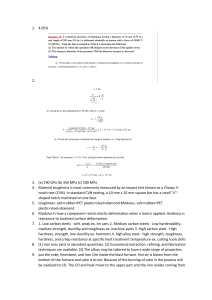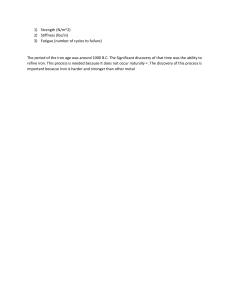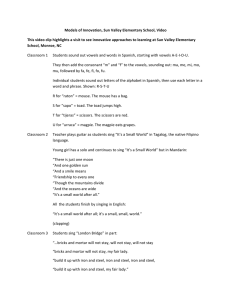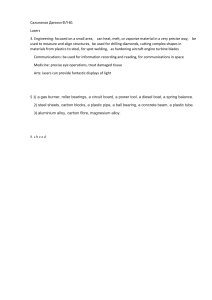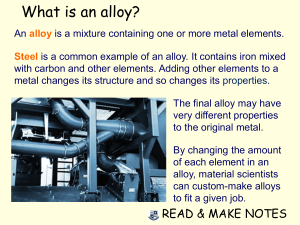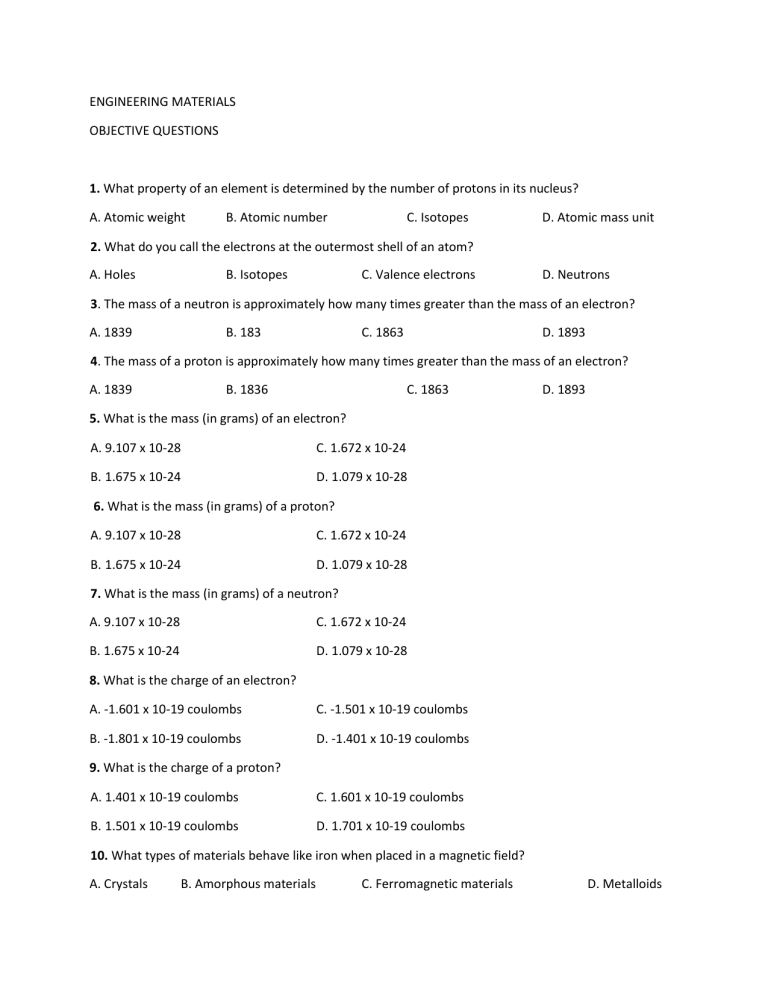
ENGINEERING MATERIALS OBJECTIVE QUESTIONS 1. What property of an element is determined by the number of protons in its nucleus? A. Atomic weight B. Atomic number C. Isotopes D. Atomic mass unit 2. What do you call the electrons at the outermost shell of an atom? A. Holes B. Isotopes C. Valence electrons D. Neutrons 3. The mass of a neutron is approximately how many times greater than the mass of an electron? A. 1839 B. 183 C. 1863 D. 1893 4. The mass of a proton is approximately how many times greater than the mass of an electron? A. 1839 B. 1836 C. 1863 D. 1893 5. What is the mass (in grams) of an electron? A. 9.107 x 10-28 C. 1.672 x 10-24 B. 1.675 x 10-24 D. 1.079 x 10-28 6. What is the mass (in grams) of a proton? A. 9.107 x 10-28 C. 1.672 x 10-24 B. 1.675 x 10-24 D. 1.079 x 10-28 7. What is the mass (in grams) of a neutron? A. 9.107 x 10-28 C. 1.672 x 10-24 B. 1.675 x 10-24 D. 1.079 x 10-28 8. What is the charge of an electron? A. -1.601 x 10-19 coulombs C. -1.501 x 10-19 coulombs B. -1.801 x 10-19 coulombs D. -1.401 x 10-19 coulombs 9. What is the charge of a proton? A. 1.401 x 10-19 coulombs C. 1.601 x 10-19 coulombs B. 1.501 x 10-19 coulombs D. 1.701 x 10-19 coulombs 10. What types of materials behave like iron when placed in a magnetic field? A. Crystals B. Amorphous materials C. Ferromagnetic materials D. Metalloids 11. What do you call the distinct pattern in space which the atoms of metal arranged themselves when they combine to produce a substance of recognizable size? A. Space-lattice B. Crystal C. Grain D. Unit cell 12. What are considered as the “building blocks” for engineering materials? A. Atoms B. Elements C. Matters D. Compounds 13. What is a pure substance that cannot be broken down by chemical means to a simpler substance? A. Atom B. Element C. Compound D. Matter 14. What determines the ability of atoms to combine with other atoms? A. The valence electrons C. The atomic number B. The number of electrons D. The atomic weight 15. What is the generally accepted nominal mass of a proton? A. 1 AMU B. 10 AMU C. 0.1 AMU D. 5 AMU 16. What is the term used to describe the amount of energy that is given off when an electron moves from one orbit to a lower orbit? A. Valency B. Quantum C. Fusion D. Fission 17. What refers to a metal combined with one or more other elements? A. Mixture B. Compound C. Alloy D. Molecule 18. What refers to chemically combined elements with definite proportions of the component elements? A. Mixture B. Molecule C. Compound D. Alloy 19. What refers to a physical blend of two or more substances? A. Molecule B. Mixture C. Alloy D. Compound 20. What is the smallest part of a compound that still retains the properties of that compound? A. Alloy B. Element C. Molecule D. Unit cell 21. When a solid has a crystalline structure, the atoms arranged in repeating structures called _____. A. Lattice B. Unit cell C. Crystal 22. What type of bonding refers to the sharing of electrons? A. Covalent bond C. Metallic bonding B. Van der Waals bonding D. Ionic bonding D. Domain 23. What refers to a crystal imperfection characterized by regions of severe atomic misfit where atoms are not properly surrounded by neighbor atoms? A. Discrystallization B. Dislocation C. Slip step D. Dispersion 24. What do you call metals reinforced by ceramics or other materials, usually in fiber form? A. Metalloids B. Matrix alloys C. Metal lattices D. Metal matrix composite 25. What is the usual valence of nonmetallic elements? A. 5 B. 6 C. 7 D. All of the choices 26. Metalloids have a valence of _____ A. 3 B. 4 C. 5 D. unity 27. What is a combination of one or more metals with a nonmetallic element? A. Metalloid B. Matrix composite C. Inert D. Ceramic 28. What do you call an atom that has lost or gain an electron? a. Ion b. Cation c. Hole d. Neutron 29. Polymer comes from Greek words “poly” which means “many” and “meros” which means ______. A. Metal B. Material C. Part D. Plastic 30. The engineering materials known as “plastics” are more correctly called ______. A. Polyvinyl chloride B. Polymers C. Polyethylene D. Mers 31. What is a combination of two or more materials that has properties that the components materials do not have by themselves? A. Compound B. Composite C. Mixture D. Matrix 32. What is a reference sheet for the elements that can be used to form engineering materials? A. Periodic table C. Building blocks of materials B. Truth table D. Structure of materials 33. Who has been accepted as the author of the periodic table which was developed by chemists in the min-nineteenth century? A. Vickers B. Knoop C. Rockwell D. Mendeleev 34. What physical property of a material that refers to the point at which a material liquefies on heating or solidifies on cooling A. Melting point B. Curie point C. Refractive index D. Specific heat 35. What physical property of a material that refers to the temperature at which ferromagnetic materials can no longer be magnetized by outside forces? A. Melting point C. Thermal expansion B. Thermal conductivity D. Curie point 36. What is the ratio of the velocity of light in a vacuum to its velocity in another material? A. Refractive index B. Poisson ratio C. Density D. Mach number 37. What physical property of a material refers to the amount of weight gain (%) experienced in a polymer after immersion in water for a specified length of time under a controlled environment? A. Dielectric strength C. Water absorption B. Electric resistivity D. Thermal conductivity 38. What physical property of a material that refers to the rate of heat flow per unit time in a homogenous material under steady-state conditions, per unit area, per unit temperature gradient in a direction perpendicular to area? A. Thermal expansion C. Heat distortion temperature B. Thermal conductivity D. Water absorption 39. What is the absolute value of the ratio of the transverse strain to the corresponding axial strain in a body subjected to uniaxial stress? A. Poisson's ratio B. Euler’s ratio C. Refractive index D. Dielectric index 40. What physical property of a material refers to the highest potential difference (voltage) of an insulating material of given thickness can withstand for a specified time without occurrence of electrical breakdown through its bulk? A. Thermal expansion B. Conductivity C. Dielectric strength D. Electrical resistivity 41. What physical property of a material refers to the ratio of the amount of heat required to raise the temperature of a unit mass of a substance 1 degree to the heat required to raise the same mass of water to 1 degree? A. Specific heat B. Latent heat C. Heat of fusion D. Heat of fission 42. What physical property of a material refers to the temperature at which a polymer under a specified load shows a specified amount of deflection? A. Curie temperature C. Heat distortion temperature B. Specific heat D. Thermal conductivity 43. What mechanical property of a material refers to the nominal stress at fracture in a tension test at constant load and constant temperature? A. Creep strength C. Compressive yield strength B. Stress rapture strength D. Hardness 44. What mechanical property of a material refers to the resistance to plastic deformation? A. Rigidity B. Plasticity C. Ductility D. Hardness 45. What typical penetrator is used in Brinell hardness test? A. 10 mm ball B. 120° diamond (brale) C. 1.6 mm diameter ball D. 20° needle 46. What parameter is defined as the temperature at which the toughness of the material drops below some predetermined value, usually 15 ft-lb? A. Nil ductility temperature C. Thermal conductivity B. Curie temperature D. Heat distortion temperature 47. What is obtained by repeatedly loading a specimen at given stress levels until it fails? A. Elastic limit C. Creep B. Endurance limit or fatigue strength of material D. All of the choices 48. What dimensional property of a material refers to the deviation from edge straightness? A. Lay B. Out of flat C. Camber D. Waviness 49. What dimensional property of a material refers to a wavelike variation from a perfect surface, generally much wider in spacing and higher in amplitude than surface roughness? A. Lay B. Waviness C. Surface finish D. Out of flat 50. Wood is composed of chains of cellulose molecules bonded together by another natural polymer called _____. A. Plastic B. Lignin C. Mer D. Additive 51. What is a polymer production process that involves forming a polymer chain containing two different monomers? A. Copolymerization B. Blending C. Alloying D. Cross-linking 52. What is the generic name of a class of polymer which is commercially known as “nylon”? A. Polyacetals B. Polyamide C. Cellulose D. Polyester 53. By definition, a rubber is a substance that has at least ____ elongation in tensile test and is capable of returning rapidly and forcibly to its original dimensions when load is removed. A. 100% B. 150% C. 200% D. 250% 54. What is a method of forming polymer sheets or filmsinto three-dimensional shapes, in which the sheet is clamped on the edge, heated until it softens and sags, drawn in contact with the mold by vacuum, and cooled while still in contact with the mold? A. Calendering C. Thermoforming B. Blow molding D. Solid phase forming 55. What is a process of forming continuous shapes by forcing a molten polymer through a metal die? A. Calendering B. Thermoforming C. Lithography D. Extrusion 56. What chemical property of a material which refers to its ability to resist deterioration by chemical or electrochemical reactions with environment? A. Stereospecificity C. Conductivity B. Corrosion resistance D. Electrical resistance 57. What refers to the tendency for polymers and molecular materials to form with an ordered, spatial, three-dimensional arrangement of monomer molecules? A. Stereospecificity B. Conductivity C. Retentivity D. Spatial configuration 58. What is the ratio of the maximum load in a tension test to the original cross-sectional area of the test bar? A. Tensile strength C. Shear strength B. Yield strength D. Flexural strength 59. What is the ratio of stress to strain in a material loaded with its elastic range? A. Poisson's ratio C. Modulus of elasticity B. Refractive index D. Percent elongation 60. What is a measure of rigidity? A. Stiffness B. Hardness C. Strength D. Modulus of elasticity 61. The greatest stress which a material is capable of withstanding without a deviation from acceptable of stress to strain is called _____. A. Elongation B. Proportional limit C. Yield point D. Elastic limit 62. What refers to the stress at which a material exhibits a specified deviation from proportionality of stress and strain? A. Tensile strength C. Yield strength B. Shear strength D. Flexural strength 63. What is the amount of energy required to fracture a given volume of material? A. Impact strength C. Creep strength B. Endurance limit D. Stress rupture strength 64. What mechanical property of a material which is time- dependent permanent strain under stress A. Elongation B. Elasticity C. Creep D. Rupture 65. In tensile testing, the increase in the gage length measured after the specimen fractures within the gage length is called _____. A. Percent elongation B. Creep C. Elasticity D. Elongation 66. What is the resistance of a material to plastic deformation? A. Hardness B. Stiffness C. Creepage D. Rigidity 67. What is the maximum stress below which a material can theoretically endure an infinite number of stress cycles? A. Endurance state C. Endurance limit B. Endurance test D. Endurance strength 68. What is a substance that attracts piece of iron? A. Conductor B. Semiconductor C. Magnet D. All of the choices 69. Which of the following is a natural magnet? A. Steel B. Magnesia C. Lodestone D. Soft iron 70. Which of the following materials has permeability slightly less than that of free space? A. Paramagnetic materials C. Ferromagnetic materials B. Non-magnetic materials D. Diamagnetic materials 71. What materials has permeabilities slightly greater than that of free space? A. Paramagnetic materials C. Ferromagnetic materials B. Non-magnetic materials D. Diamagnetic materials 72. Which of the following materials have very high permeabilities? A. Paramagnetic materials C. Ferromagnetic materials B. Non-magnetic materials D. Diamagnetic materials 73. What ASTM test for tension is designated for plastics? A. A370 B. D638 C. E292 D. C674 74. What ASTM test for compression is designated for plastics? A. D648 B. D695 C. D790 D. D732 75. What ASTM test for shear strength is designated for plastics? A. D732 B. D790 C. D695 D. D638 76. What is the ASTM tension testing designation for standard methods for steel products? A. A370 B. E345 C. E8 D. C674 77. What is defined by ASTM as a material that contains as an essential ingredient an organic substance of large molecular weight, is solid in its finished state, and at some stage in its manufactured or in its processing into finished articles, can be shaped by flow? A. Metal B. Metalloid C. Plastic D. Ceramic 78. Some polymetric materials such as epoxies are formed by strong primary chemical bonds called _____. A. Metallic bond C. Cross linking B. Van der Waals bond D. Covalent bond 79. What do you call a polymer without additives and without blending with another polymer? A. Homopolymer B. Ethenic polymer C. Polyethylene D. Copolymer 80. A large molecule with two alternating mers is known as? A. Monomer B. Elastomer C. Mers D. Copolymer or interpolymer 81. What term is used to describe a polymer that has rubberlike properties? A. Vulcanize B. Elasticmer C. Polychloroprene D. Elastomer 82. What is defined as an alloy of iron and carbon, with the carbon being restricted within certain concentration limits? A. Steel B. Wrought iron C. Cast iron D. Tendons 83. What is the most popular steel refining process or technique which involves casting of steel from the BOF or electric furnace into cylindrical ingots? A. Vacuum arc remelting (VAR) C. Electron beam refining B. Vacuum induction melting (VIM) D. Electroslag refining 84. In what special refining process of steel where molten metal is poured down a tundish (chute) into an ingot mold? A. Electroslag refining C. Vacuum induction melting B. Vacuum arc remelting D. Electron beam refining 85. What type of steel has carbon as its principal hardening agent? A. Alloy steel B. Stainless steel C. Galvanized steel D. Carbon steel 86. What type of steel has 0.8% carbon and 100% pearlite? A. Austenite B. Eutectoid C. Hyper-eutectoid D. Stainless steel 87. What group of steels are water-hardened tool steels? A. Group S B. Group W C. Group O D. Group T 88. What group of steels are molybdenum high-speed steels? A. Group A B. Group D C. Group M D. Group H 89. Steels that are used for axles, gears, and similar parts requiring medium to high hardness and high strength are known as? A. Medium-carbon steel C. Very high-carbon steel B. Low-carbon steel D. High-carbon steel 90. Galvanized steel are steel products coated with _____. A. Carbon B. Sulfur C. Zinc D. Nickel 91. Low-quality steels with an M suffix on the designation intended for nonstructural application is classified as _______. A. Merchant quality C. Drawing quality B. Commercial quality D. Special quality 92. The use of acids to remove oxides and scale on hot- worked steels is known as ____. A. Tempering B. Pickling C. Machining D. Galvanizing 93. The purpose of molybdenum in steel alloying is to? A. Increase brittleness C. Reduce brittleness, combine with sulfur B. Increase dynamic and high-temperature hardness D. Increase corrosion and resistance strength and 94. Indicate the false statement. A. About 10% of the earth’s crust is iron. B. Pure iron does not have significant industrial use because it is too weak and soft. C. Steel is an alloy of carbon and iron with limits on the amount of carbon (less than 2%) D. Steel is made by reducing oxide ore of iron by thermochemical reactions in a blast furnace or direct reduction vessel. 95.What does AISI stands for? A. Asian Institute of Steel Industries C. Association of Iron and Steel Industries B. American Institute of Steel Industries D. American Iron and Steel Institute 96. What does SAE stands for? A. Society of Automotive Engineers B. Society of American Engineers C. Society of Architects and Engineers 97. What does ASTM stands for? A. Association of Steel Testing and Materials B. American Society for Testing and Materials D. Society of Alloy Engineers C. Asian Society for Testing and Materials D. Allied Society for Testing and Materials 98. What prefix in steel identification means composition varies from normal limits? A. E B. H C. X D. B 99. What prefix in steel identification means it is made in an electric furnace? A. E B. H C. X D. B 100. What letter suffix in steel identification means that it is steel with boron as an alloying element? A. xxLxx B. xxBxx C. xxHxx D. xxKxx 101. What do you call tin mill steel without a coating? A. White plate B. Tin steel free C. Black plate D. Dechromate tin 102. What combination of elements has high electrical resistance, high corrosion resistance, and high strength at red heat temperatures, making it useful in resistance heating? A. Aluminum bronze B. Nichrome C. Hastelloy D. Alnico 103. A steel cannot qualify for stainless prefix until it has at least how many percent of chromium? A. 10% B. 20% C. 25% D. 5% 104. What do you add to compensate for the remaining high iron oxide content of the steel? A. Deorizers B. Deoxidizers C. Deterrent D. Detoxifiers 105. Which of the following cast irons is a high-carbon, iron-carbon-silicon alloy? A. Gray iron B. Malleable iron C. White iron 106. Which of the following cast irons is heat-treated for ductility? A. Gray iron B. Malleable iron D. Alloy iron C. White iron 107. Which cast iron is hard and wear resistant? D. Ductile iron A. Gray iron B. Ductile iron C. White iron D. Malleable iron 108. What is considered as the general purpose, oldest type and widely used cast iron? A. Gray iron B. Ductile iron C. Alloy iron D. Malleable iron 109. The effect of manganese in cast iron is to? A. Affect the machinability, ductility and shrinkage depending on form B. Reduce hardness by combining with sulfur below 0.5% and increase hardness above 0.5% C. Deoxidize molten cast iron D. Increase fluidity and lowers melting temperature 110. The effect of aluminum in cast iron is to? A. Increase hardness above 0.5% B. Deoxidize molten cast iron C. Affect the machinability, ductility and shrinkage depending on form D. Reduce hardness by combining with sulfur below 0.5% 111. The effect of silicon in cast iron is to? A. Reduce hardness by combining with sulfur below 0.5% and increase hardness above 0.5% B. Increase fluidity and lowers melting temperature C. Softens iron and increases ductility below 3.25%, hardens iron above 3.25% and increase acid and corrosion resistance above 13% D. Deoxidizes molten cast iron 112. Iron is said to be abundant in nature. About how many percent of the earth’s crust is iron? A. 10% B. 5% C. 20% D. 8% 113. What is the advantage of quench hardening? A. Improved strength C. Wear characteristics B. Hardness D. All of the choices 114. What is the lowest-temperature diffusion-hardening process and does not require a quench? A. Carburizing B. Tempering C. Nitriding D. Heat-treating 115. The following statements are true except one. Whicch one? A. Carburizing does not harden a steel B. Flame and induction hardening require the use of hardenable steels C. Quench-hardened steel does not require tempering to prevent brittleness D. Induction hardening is usually most efficient on small parts 116. Which of the following is a requirement for hardening a steel? A. Heating to the proper temperature C. Adequate quench B. Sufficient carbon content D. All of the choices 117. What field of study encompasses the procurement and production of metals? A. Metallurgy B. Geology C. Material science D. Metalgraphy 118. What do you call earth and stones missed with the iron oxides? A. Hematite B. Magnetite C. Gangue D. Ore 119. What is a coal that has been previously burned in an oxygen-poor environment? A. Tuyere B. Coke C. Diamon D. Hematite 120. What is the most common alloying ingredient in copper? A. Brass B. Zin C. Nickle D. Aluminum 121. What refers tot eh casehardening process by which the carbon content of the steel near the surface of a part is increased? A. Carburizing B. Annealing C. Normalizing D. Martempering 122. What is the process of heating a hardened steel to any temperature below the lower critical temperature, followed by any desired rate of cooling? A. Normalizing B. Spheroidizing C. Carburizing D. Tempering 123. What is defined as an intimate mechanical mixture of two or more phases having a definite composition and a definite temperature of transformation within the solid state? A. Pearlite B. Eutectoid C. Austernite D. Delta solid solution 124. What is the most undesirable of all elements commonly found in steels? A. Sulfur B. Phosphorus C. Silicon D. Manganese 125. What impurity in steel can cause “red shortness”, which means the steel becomes unworkable at high temperature? A. Sulfur B. Silicon C. Manganese D. Phosphorus 126. What is a method of casehardening involving diffusion in which the steel to be casehardened is machined, heat- treated, placed in an air-tight box and heated to about 1000°F? A. Annealing B. Normalizing C. Carburizing D. Nitriding 127. What is a process of producing a hard surface in a steel having a sufficiently high carbon content to respond to hardening by a rapid cooling of the surface? A. Cyaniding B. Nitriding C. Flame hardening most common reinforcement for polymer composites? A. Boron B. Ceramic D. Induction hardening 128. What is the C. Graphite D. Glass fiber 129. In electrochemistry, oxidation is a loss of _____. A. Ion B. Electron C. Proton D. Anode 130. What is the process of putting back the lost electrons to convert the ion back to a metal? A. Oxidation B. Corrosion C. Reduction D. Ionization 131. Oxidation is an electrochemical cell always takes place where? A. At the anode C. At the electrode B. At the cathode D. At both cathode and anode 132. Reduction in an electrochemical cell always takes place where? A. At the anode C. At the electrode B. At the cathode D. At both cathode and anode 133. What do you call a fluid that conducts electricity? A. Electrolyte B. Water C. Solution D. Acid 134. The _____ of an environment serves as a measure of the strength of acids or bases. A. pH measurement B. Humidity C. Passivity D. Impurities C. 7 D. 9 135. What is the pH value for a neutral solution? A. 3 B. 5 136. The solutions with pH values from 1 to 6 are _____. A. Base B. Alkaline C. Neutral D. Acid 137. The solutions with pH values from 7 to 12 are ____. A. Base B. Alkaline C. Neutral 138. “pH” stands for _____. D. Acid A. Positive helium ion B. Positive hydrogen ion C. Polyhelium 139. What is defined as a local corrosion damaged characterized by surface cavities? A. Cracking B. Pitting D. Polyhydrate C. Cavitation 140. What do you call the removal of zinc from brasses? D. Erosion A. Dezincification C. Stabilization B. Graphitization 141. What is the scaling off of a surface in flakes or layers as the result of corrosion? D. Dealloying A. Expoliation D. Fretting B. Corrosion fatigue C. Scaping 142. What corrosion occurs under organic coatings on metals as fine, wavy hairlines? A. Stray current corrosion C. Filiform corrosion B. Microbiological corrosion D. Fretting corrosion 143. What refers to the deterioration of material by oscillatory relative motion of small amplitude (20 to 100 μm) between two solid surfaces in a corrosive environment? A. Stray current corrosion C. Filiform corrosion B. Microbiological corrosion D. Fretting corrosion 144. Indicate the false statement about corrosion. A. Plastics and ceramics are immune to many forms of C. Passivity is a prerequisite for corrosion because they are not good conductors of the corrosion protection of many electricity. metals. B. The corroded member in a corrosion cell is the cathode. D. Corrosion of metals is usually electrochemical in nature. 145. Steel is an alloy of iron and carbon with limits on the amount of carbon to less than ____ percent. A. 2 B. 3 C. 4 D. 1% to 5% 146. What is the approximate chromium range of a ferritic stainless steel? A. 12% to 18% B. 10% to 12% C. 16% to 20% D. 20% to 24% 147. Indicate false statement about stainless steel? A. The density of stainless steel is about the same as carbon low-alloy steels. B. Stainless steels are poor conductors of heat. C. Stainless steels are poor conductors of electricity. D. Stainless steels have tensile moduli greater than those of carbon and alloy steels 148. What are the four major alloying elements of austenitic stainless steels? A. Iron, chromium, carbon and nickel C. Iron, chromium, carbon and zinc B. Iron, chromium, zinc and nickel D. Iron, chromium, carbon and copper 149. The electrical resistance of stainless steels can be as much as ___ times that of carbon steels. A. 5 B. 6 C. 10 D. 15 150. What refers to a shape achieved by allowing a loquid to solidify in a mold? A. Casting B. Molding C. Forming 151. Which of the following is NOT a hardware requirement for die casting? A. Water-cooled metal cavities C. Ejection mechanism B. Machined metal holding blocks D. Metal mold (maching halves) D. All of the choices 152. What cast iron has nodular or spheroidal graphite? A. Ductile iron B. Wrought iron C. Gray iron D. White iron 153. What is a process for making glass-reinforced shapes that can be generated by pulling resin impregnated glass strands through a die? A. Continuous pultusion C. Vacuum bag forming B. Bulk molding D. Resin transfer moulding 154. What is a natural substance that makes up a significant portion of all plant life? A. Cellulose B. Polyacetal C. Polycarbonates D. Polyimides 155. What term is used to denote a family of thermosetting polymers that are reaction products of alcohols and acids? A. Alkaline B. Alkydes C. Alcocids D. Aldehyde 156. What is the AISI-SAE steel designation for nickel 3.50 alloy? A. 13XX B. 23XX C. 25XX D. 31XX 157. What is the AISI-SAE designation for resulfurized and rephosphorized carbon steel? A. 13XX B. 31XX C. 23XX D. 12XX 158. The Group H steels can be used in what temperature range? A. 600°C to 1100°C C. 1100°C to 2000°C B. 1000°C to 1500°C D. 200°C to 800°C 159. The following are primary alloying ingredients of Group H steels except: A. Molybdenum B. Tungsten C. Cobalt D. Chromium 160. The chrome-molybdenum steels contain how many percent of molybdenum? A. 0.10 B. 0.20 C. 0.30 D. 0.40 161. The chrome-vanadium steels contain how many percent of vanadium? A. 0.15 to 0.30 C. 0.30 to 0.45 B. 0.05 to 0.15 D. 0.45 to 0.60 162. Manganese steel usually contains how many percent of manganese? A. 1 to 5 B. 5 to 10 C. 11 to 14 D. 14 to 18 163. The wear-resistance of this material is attributed to its ability to ____, that is, the hardness is increased greatly when the steel is cold worked. A. Cold harden C. Cool-temperature resistant B. Stress harden D. Strain harden 164. The special chrome steels of the stainless variety contain how many percent of chromium? A. 4 to 8 B. 9 to 10 C. 11 to 17 D. 17 to 21 165. What refers to the application of any process whereby the surface of steel is altered so that it will become hard? A. Carburizing B. Casehardening C. Annealing D. Surfacehardening 166. What refers to the ability of steel to be hardened through to its center in large section? A. Malleability B. Hardenabilty C. Spheroidability D. Rigidity 167. What is the equilibrium temperature of transformation of austenite to pearlite? A. 1000° F B. 1333° F C. 1666° F D. 1222° F 168. What structure is formed when transformation occurs at temperatures down to the knee of the curve? A. Pearlite B. Bainite C. Austenite D. Martensite 169. What allotropic form of iron refers to iron that has a temperature range of room temperature to 1670°F? A. Beta iron B. Gamma iron C. Delta iron D. Alpha iron 170. The alpha iron will become paramagnetic at temperature above _____. A. 770°C B. 550°C C. 660°C D. 440°C 171. What steel surface hardening process requires heating at 1000°F for up to 100 hours in an ammonia atmosphere, followed by slow cooling? A. Nitriding B. Flame hardening 172. What s the chief ore of tin? C. Precipitation hardening D. Carburizing C. Ilmanite D. Galena 174. What is the chief ore of titanium? C. Sphalerite D. Ilmanite A. Sphalerite C. Bauxite D. Cassiterite A. Cassiterite B. Bauxite 173. What is the chief ore of zinc? A. Cassiterite B. Bauxite B. Ilmanite 175. What is a mixture of gibbsite and diaspore, of which aluminum is derived? A. Bauxite B. Rutile C. Galena D. Sphalerite 176. The term “brass” is very commonly used to designate any alloy primarily ___ and ____. A. Copper and zinc C. Copper and aluminum B. Aluminum and zinc D. Zinc and nickel 177. The term “bronze” is used to designate any alloy containing: A. Copper and zinc C. Copper and nickel B. Copper and aluminum D. Copper and tin 178. In a system of designating wrought aluminum alloys, a four digit number is used. What does the first digit indicates? A. The purity of aluminum C. The alloy group B. The identity of the alloy D. The strength of the alloy 179. In a system of designating wrought aluminum alloys, what does the second digit represents? A. The purity of aluminum C. The modifications of the alloy group or impurity limits B. The identity of the alloy D. The alloy group 180. In the system of designating wrought aluminum alloys, the letter F that follows the number indicates what condition of the alloy? A. As fabricated B. Strain hardened C. Annealed D. Artificially aged 181. The following alloys are the chief alloys that are die-cast except: A. Zinc alloys B. Magnesium alloys C. Manganese alloys D. Aluminum alloys 182. What is the minimum tensile strength of Gray Cast Iron class 50? A. 25000 lbf/in2 B. 35000 lbf/in2 C. 50000 lbf/in2 D. 100000 lbf/in2 183. What is the carbon content of wrought iron? A. Less than 0.1 percent C. More than 0.1 percent B. Exactly 0.1 percent D. Ranges from 0.1 percent to 0.2 percent 184. Alnico is an alloy containing how many percent nickel? A. 10% B. 14% C. 18% D. 22% 185. The most common beta brass with a composition of 60% copper and 40% zinc is called ________. A. Yellow brass B. Red brass C. Muntz metal D. White brass 186. Red brass contains about how many percent of zinc? A. 10% B. 15% C. 20% D. 25% 187. Yellow brass contains approximately how many percent of zinc? A. 20% B. 50% C. 30% D. 40% 188. Indicate the false statement. A. Aluminum bronzes contain no tin. C. Bronze is a copper-tin alloy. B. Silicon bronzes are usually used for marine high-strength fasteners. D. Tin is relatively soluble application and in copper. 189. What is the most abundant metal in nature? A. Aluminum B. Steel C. Iron D. Copper 190. Indicate the false statement about aluminum. C. It has 1/3 the weight of steel. C. It has high strength-to-weight ratio. D. It has 1/3 of the stiffness of steel. D. It has poor thermal and electrical conductivity. 191. What is the effect to aluminum with iron as the alloying element? A. Reduce hot-cracking tendencies in casting C. Lowers castability B. Improve conductivity D. Improves machinability 192. What is the effect to aluminum with cooper as alloying element? A. Increases strength up to 12% C. Improves machinability B. Reduces shrinkage D. Increases fluidity in casting 193. Which of the following are two well-known nickel alloys with magnetic properties ideal for permanent magnets? A. Invar and Nilvar C. Elinvar and Invar B. Nichrome and Constantan D. Alnico and Cunife 194. The Portland cement is manufacture from the following elements except: A. Lime B. Silica C. Alumina D. Asphalt 195. What gives the average ratio of stress to strain for materials operating in the nonlinear region in the stress- strain diagram? A. Modulus of elasticity B. Proportionality limit C. Secant modulus D. Tangent modulus 196. What is the ratio of the ultimate failure strain to the yielding strain? A. Poisson's ratio B. Ductility C. Resilience D. Fatigue 197. What test determines the hardenability of a steel specimen? A. Jominy end-quench test C. Gibb’s phase test B. The lever rule D. Stress relief test 198. What steel relief process is used with hypoeutectoid steels to change martenite into pearlite? A. Tempering B. Normalizing C. Annealing D. Spheroidizing 199. What is another term for tempering? A. Recrystallization C. Spheroidizing B. Annealing D. Drawing or toughening 200. All are steel surface hardening processes except one. Which one? A. Carburizing B. Flame hardening C. Nitriding D. Annealing
